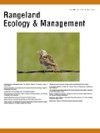Movements and Survival of Adult Mule Deer Bucks in a Wildlife Enterprise Trophy Ranching Context
IF 2.4
3区 环境科学与生态学
Q2 ECOLOGY
引用次数: 0
Abstract
Ranch economics are increasingly dependent upon wildlife enterprises throughout the arid Southwestern USA and Mexico, and mule deer (Odocoileus hemionus) are perhaps the most economically important species in the region. Because significant investments by landowners are necessary for trophy management (i.e., high adult sex [buck:doe] ratio, high buck survival, and advanced [older] buck age structure), loss of bucks to adjacent properties and increased mortality on ranches (both a potential consequence of more intense competition among deer under trophy management) could represent significant disincentives to managers. Hence, we evaluated the movements and survival of adult bucks in a ranch context in northeastern New Mexico, USA, to evaluate these concerns. We found that both concerns were warranted, especially for small ranching enterprises. Despite small home ranges (16.0 km2) and core areas (4.4 km2) due to intensive management for quality deer habitat, deer spent ca. 40% of their time on adjacent properties regardless of season, and half of deer with >50% of their annual ranges on adjacent properties were harvested there. Similarly, low body condition postrut predisposed all age (year)-classes of bucks to nonharvest mortality, likely an unavoidable consequence of trophy management. The most important consideration with respect to off-ranch movements is ranch size; properties < 4× larger than adult buck home ranges in arid Southwestern environments should question if investment in trophy buck production is viable. For ranches lacking intensive deer habitat improvement programs, adult buck home ranges are likely > 20 km2, suggesting a size of ≥ 80 km2 for ranches to ensure that a significant proportion of adult bucks are full-time residents, and hence allow managers to realize returns from trophy management.
野生动物事业奖杯牧场环境下成年骡鹿的运动和生存
在干旱的美国西南部和墨西哥,牧场经济越来越依赖于野生动物企业,而骡鹿(Odocoileus hemionus)可能是该地区最重要的经济物种。由于土地所有者的大量投资对于战利品管理是必要的(例如,高成年性别[雄鹿:母鹿]比例,高雄鹿存活率和先进的[老年]雄鹿年龄结构),雄鹿在邻近财产中的损失和牧场死亡率的增加(两者都是在战利品管理下鹿之间更激烈竞争的潜在后果)可能会对管理者产生重大的不利影响。因此,我们在美国新墨西哥州东北部的一个牧场环境中评估了成年雄鹿的运动和生存,以评估这些问题。我们发现,这两种担忧都是有根据的,尤其是对小型牧场企业而言。尽管由于对优质鹿群栖息地的集约化管理,鹿群的活动范围(16.0平方公里)和核心区域(4.4平方公里)较小,但无论季节如何,鹿群在邻近的土地上花费了大约40%的时间,而在邻近的土地上,有一半的鹿群(年活动范围为50%)在那里收获。同样,发育后身体状况不佳的雄鹿易在未收获时死亡,这可能是战利品管理不可避免的后果。关于牧场外运动最重要的考虑因素是牧场规模;属性& lt;在干旱的西南环境中,比成年雄鹿的家庭范围大4倍,应该质疑投资于雄鹿生产是否可行。对于缺乏密集的鹿栖息地改善计划的牧场,成年雄鹿的家园范围可能是;20平方公里,建议≥80平方公里的牧场面积,以确保成年雄鹿的很大一部分是全职居民,从而使管理者从战利品管理中获得回报。
本文章由计算机程序翻译,如有差异,请以英文原文为准。
求助全文
约1分钟内获得全文
求助全文
来源期刊

Rangeland Ecology & Management
农林科学-环境科学
CiteScore
4.60
自引率
13.00%
发文量
87
审稿时长
12-24 weeks
期刊介绍:
Rangeland Ecology & Management publishes all topics-including ecology, management, socioeconomic and policy-pertaining to global rangelands. The journal''s mission is to inform academics, ecosystem managers and policy makers of science-based information to promote sound rangeland stewardship. Author submissions are published in five manuscript categories: original research papers, high-profile forum topics, concept syntheses, as well as research and technical notes.
Rangelands represent approximately 50% of the Earth''s land area and provision multiple ecosystem services for large human populations. This expansive and diverse land area functions as coupled human-ecological systems. Knowledge of both social and biophysical system components and their interactions represent the foundation for informed rangeland stewardship. Rangeland Ecology & Management uniquely integrates information from multiple system components to address current and pending challenges confronting global rangelands.
 求助内容:
求助内容: 应助结果提醒方式:
应助结果提醒方式:


